Hole in the Clouds
Oct 1, 2009
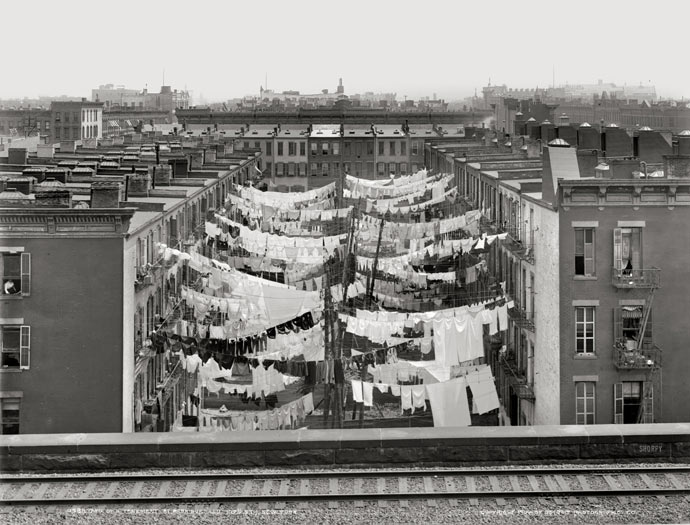
Obviously, this picture was taken on a Monday. The scene is the tenement backyard at Park Avenue and 107th Street in New York, probably in the year 1900.
Setting up these clotheslines was not a trivial task, especially on the higher floors. A man would come around calling out "I climb poles!" and for about 25 cents he'd climb up and run the rope out over the pulleys. He also sold rope and pulleys, but if you'd planned ahead and bought them from the hardware store, you could save a few cents.
Notice the train track at the bottom of the photo--I'm guessing the whites were whiter at the far end of the block. Just on the other side of the tracks is the building where baseball player Lou Gehrig grew up, a few years after this picture was taken.
I suggest viewing this image as large as possible, so you can peep into the windows.
New York
vintage
cityscape
tenement
laundry
(Image credit: Detroit Publishing Co., via Shorpy)
Jan 10, 2011
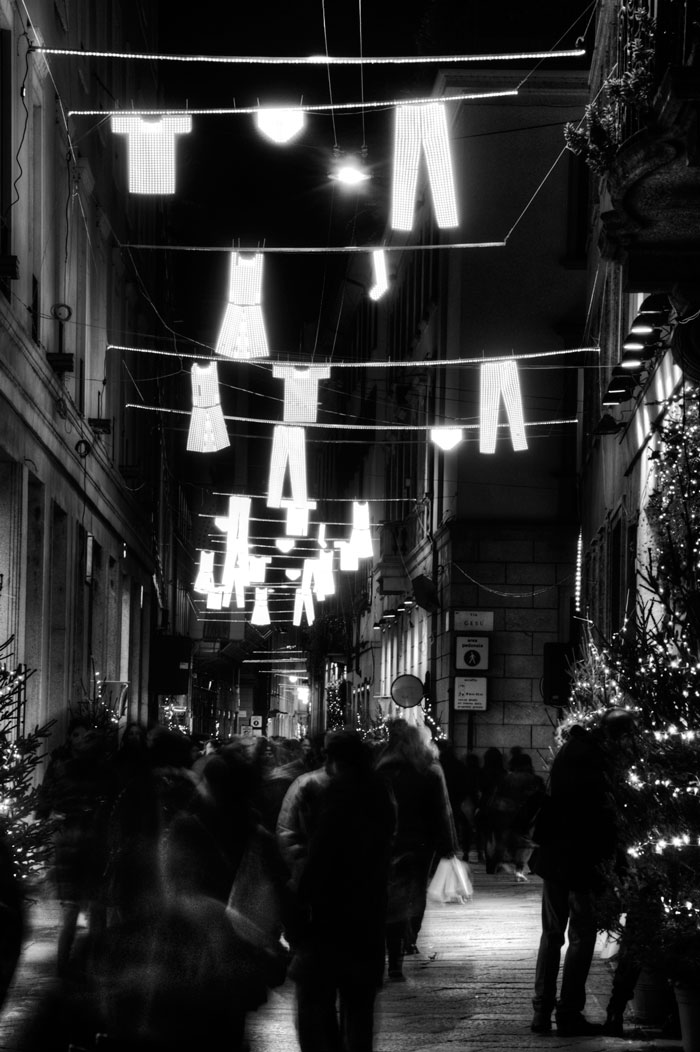
Today is the last day of Milan's second annual LED Festival, a celebration of outdoor lighting in the city that a hundred years ago became the first in Europe to electrify its street lights and street cars. This year's festival featured sixty installations totaling more than 600,000 LED bulbs.
On Via della Spiga, artist Fabrio Novembre hung out laundry in lights, alluding to a Sophia Loren movie, Iori, Oggi, Domani--Yesterday, Today, and Tomorrow.
It just doesn't seem fair, somehow, that when they dole out the cinematic icons, Milan gets Sophia Loren while here in Philadelphia we have to make do with Sylvester Stallone....
laundry
streetscape
Milan
Italy
LED Festival
lights
(Image credit: Lorenzo Bianchi)
Feb 12, 2017
 A sample of lint from the trap in our clothes dryer yielded this strand of something: a hair, maybe, or some kind of fiber that is fixing to fail.
A sample of lint from the trap in our clothes dryer yielded this strand of something: a hair, maybe, or some kind of fiber that is fixing to fail.
We examined the lint with a scanning electron microscope, which magnified it about 927 times by shooting electrons at it and noting how they bounced back. If we'd had a regular old optical microscope, we might have been able to reach this same level of magnification, though we'd be approaching the upper limits of that technology.
Electron microscopes can detect details hundreds of times smaller than optical scopes because electrons travel in more or less straight paths while visible light undulates in waves. The downside is that electrons can't see in color and can't travel much beneath the surface of things, no matter how transparent or translucent that surface might be.
All in all, however, if lint is what you're wanting to look at, then a scanning electron microscope might be just the tool for the job.
With its help, we calculated the width of this strand of whatever it is at about 20 microns–about one fiftieth of a millimeter. The hairs on our heads are usually more like 50 microns in diameter, so this probably isn't that.
This strand of whatever it is has obviously been through the wringer, even though our current washing machine doesn't have a wringer. The strand has been stressed, and were it not for a couple of microns of badly fraying inner strength at its core, it would have snapped completely.
Which does lead to speculation that what we're looking at here is My Last Nerve. . . .
But there are some other possibilities. Such as dog hair: dog hairs average about 25 microns in diameter, more or less in the same ballpark as this strand. Dog hairs often show a scaly pattern on their outer cuticles that looks kinda like the faint pattern we can sorta make out on what's left of the outer surface of this thing. And of course, finding a dog hair in the lint trap at our house, or pretty much anywhere else in our house, isn't completely freakish.
But really: could a dog hair get this mangled and shredded just from normal laundry processes? We want to beg off from a definitive answer; although we've worn many different hats over the years, we have never, ever presented ourselves as expert in the forensic analysis of dog hairs.
We've not yet, however, run out of options. Couldn't this thing be a fabric fiber from some item of clothing?
That electron microscope sure did come in handy.
laundry
hair
photography
Seattle
micrography
forensics
North Seattle College
scanning electron miscroscope
fiber
lint
(Image credit: North Seattle College Nanotechnology Lab)
Mar 16, 2017
 At a hotel, every day is wash day.
At a hotel, every day is wash day.
laundry
clothesline
hotel
wash
Mar 20, 2017
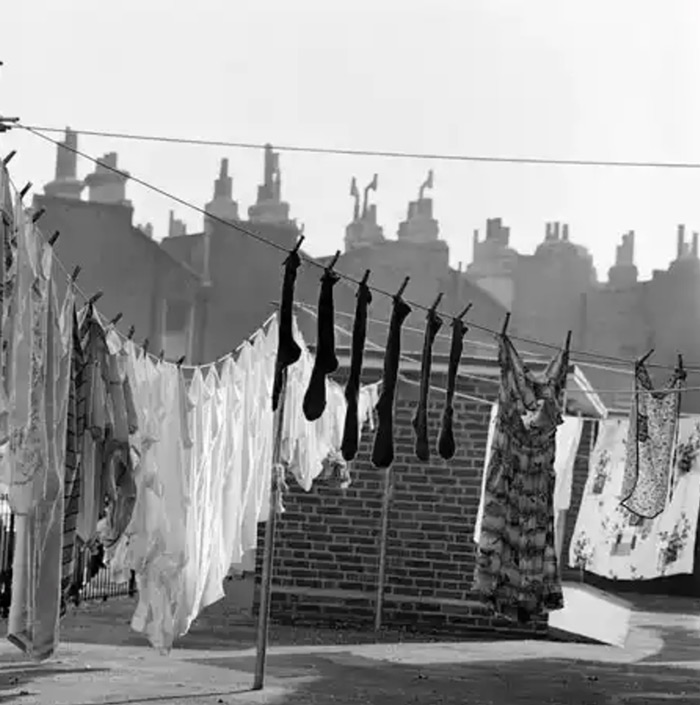 In 1960, British photographer John Gay (who was actually born Hans Göhler, in Karlsruhe, Germany) shot these clotheslines in front of the chimneyline of Islington, London.
In 1960, British photographer John Gay (who was actually born Hans Göhler, in Karlsruhe, Germany) shot these clotheslines in front of the chimneyline of Islington, London.
A confession: I miss clotheslines. Don't miss lugging baskets of soggy clothes up the basement steps and out across the yard. Don't miss slapping at mosquitoes with a mouthful of clothespins. Don't miss convincing myself it won't rain when of course it will, and it does. Don't miss how stiff the clothes are when they're finally back inside.
I just miss seeing clotheslines when I walk the streets and alleys of my neighborhood, or any neighborhood. Nowadays, backyards look lifeless and uninteresting. Doubtless, this is a small price to pay for progress, and this nostalgia of mine is a small and silly thing, but still.
So now and for a while to come, Monday will be laundry day on Hole in the Clouds.
cityscape
laundry
London
skyline
clothesline
roofscape
1960
Islington
chimneys
(Image credit: John Gay)
Mar 27, 2017

laundry
children
clothesline
fence
pink house
Apr 10, 2017
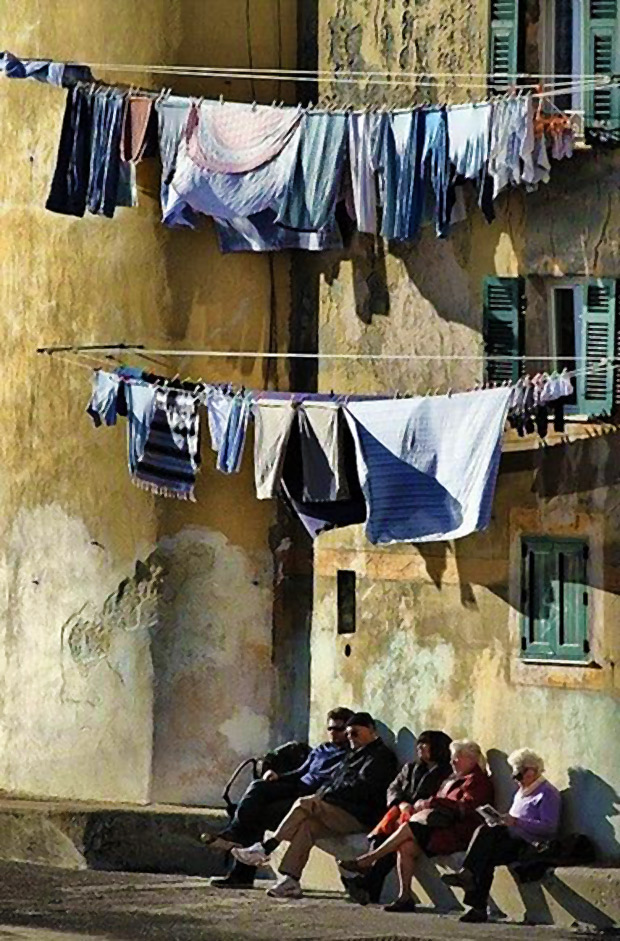
Suspendu, says the caption. In Napoli.
laundry
streetscape
Italy
windows
clothesline
Naples
Napoli
shutters
Apr 24, 2017
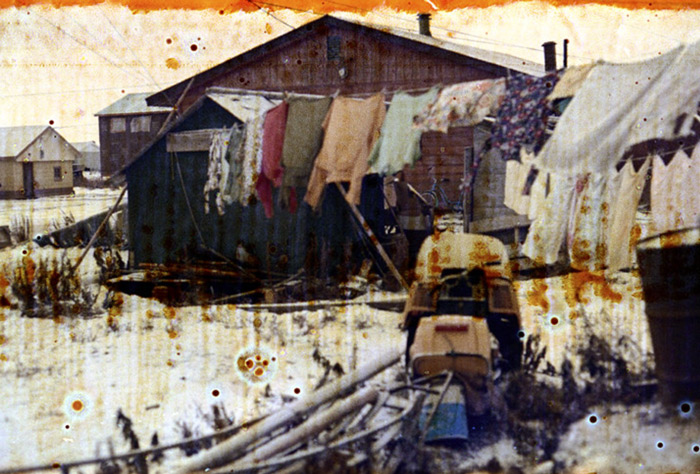 An unidentified coastal village in Alaska, in the fall of 1972.
An unidentified coastal village in Alaska, in the fall of 1972.
Scanned image from a heat-damaged negative in the collection of the late Nick DeWolf.
laundry
Alaska
clothesline
1972
(Image credit: Nick DeWolf)
May 1, 2017
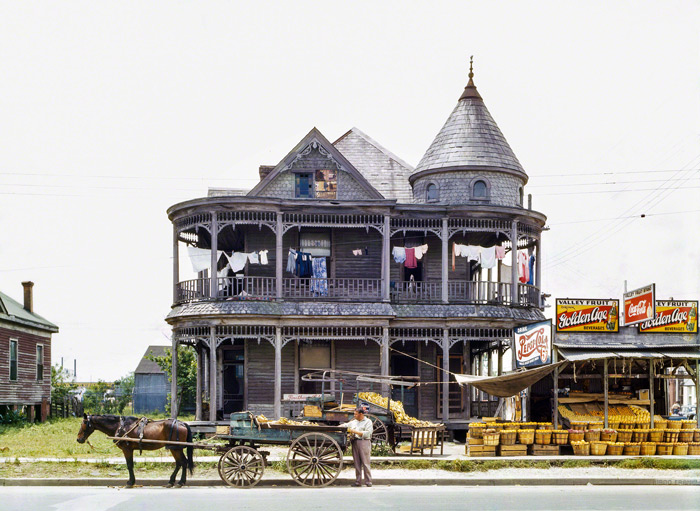 Abe Cweren, an immigrant from Poland who arrived in Texas in 1922, is unloading bananas from his wagon in 1943, at the Valley Fruit stand on Franklin Street in Houston.
Abe Cweren, an immigrant from Poland who arrived in Texas in 1922, is unloading bananas from his wagon in 1943, at the Valley Fruit stand on Franklin Street in Houston.
The house behind the fruit stand was built before 1900 by a family named Fredericks; in the 1940 census, three years before this photo was taken, the home's inhabitants were listed as a 30-year-old night-club chef named Rudolph Martinez, his wife Candalanca, son Rudolph Jr., sister Isabell Samora, and her two children, Raymond and Joe Louis.
The banana man wrote on the side of his wagon, "Jockey Cweren, Kentucky Derby."
laundry
streetscape
clothesline
houses
wagon
bananas
1943
Abe Cweren
fruit stand
Kodachrome
(Image credit: John Vashon via Shorpy)
Jan 29, 2018
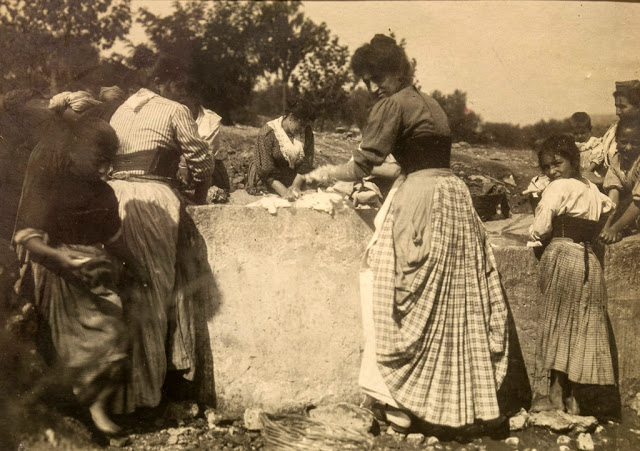 Women washing clothes circa 1900 in Alatri, Italy, 100 kilometers southeast of Rome.
Women washing clothes circa 1900 in Alatri, Italy, 100 kilometers southeast of Rome.
laundry
Italy
1900
women
Alatri
Feb 12, 2018
 Back alley in the Mission District, San Francisco, 1936. If you're interested in the apartment advertised, they want $20 a month for rent.
Back alley in the Mission District, San Francisco, 1936. If you're interested in the apartment advertised, they want $20 a month for rent.
laundry
San Francisco
backyard
alleyscape
clothesline
signage
1936
for rent
Mission District
(Image credit: Dorothea Lange via Shorpy)
Mar 5, 2018
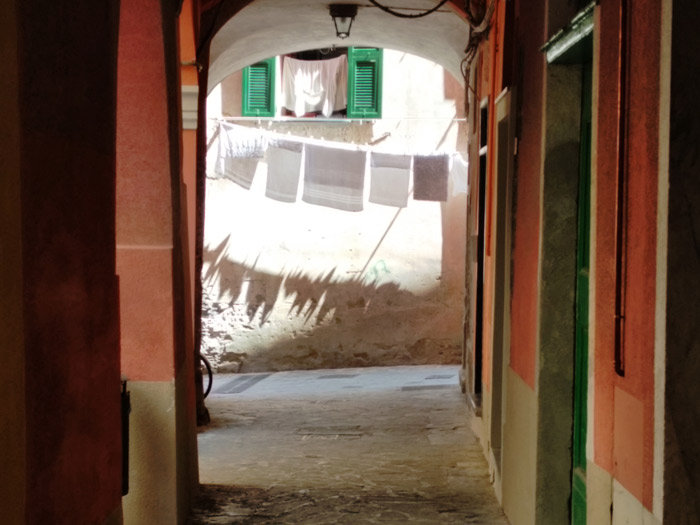
laundry
Italy
window
clothesline
(Image credit: K. Maldre)
Mar 12, 2018
 Quarteri Spagnoli.
Quarteri Spagnoli.
laundry
streetscape
Italy
clothesline
Naples
Mar 19, 2018

laundry
Havana
Cuba
clothesline
yardscape
trees
roofscape
Jaimanitas
Fusterlandia
(Image credit: my phone)
Mar 26, 2018
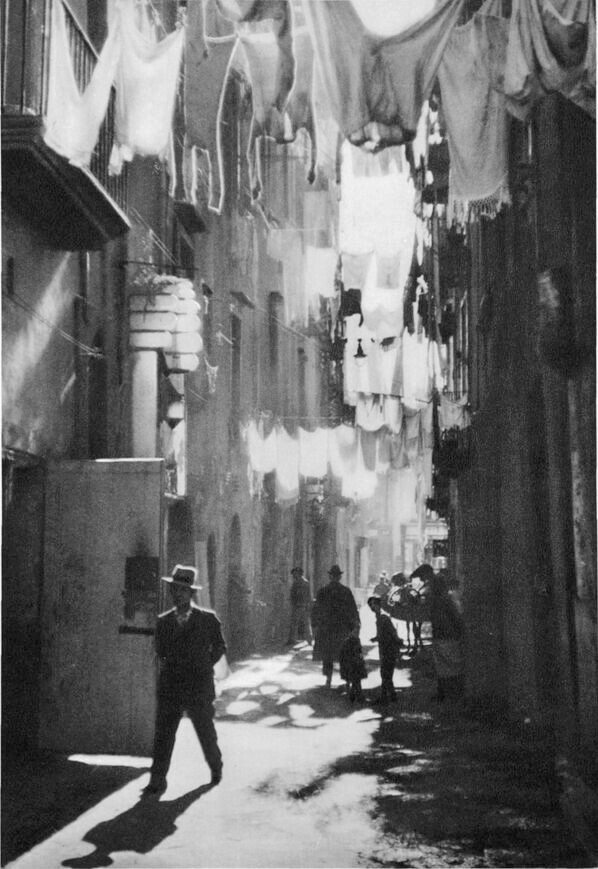
Quarteri Spagnoli, 1929.
laundry
streetscape
Italy
clothesline
Naples
1929
Quartori Spagnoli
Apr 9, 2018
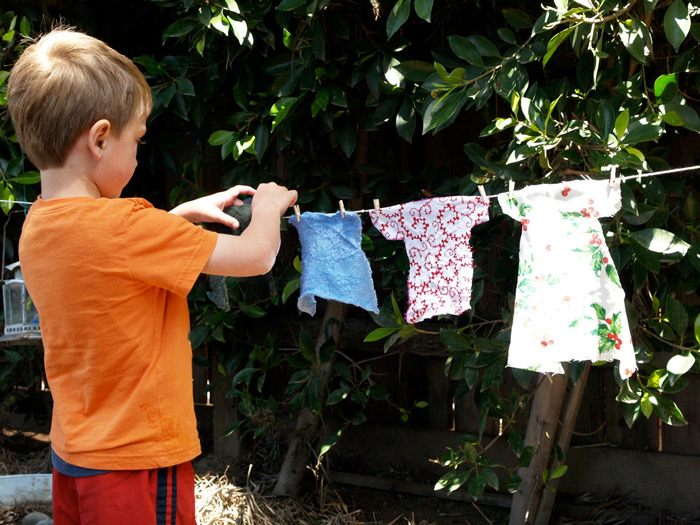 There are many stories of children reading, or listening to, the adventures of Laura and her family in Laura Ingalls Wilder's Little House books and deciding to try that way of life themselves.
There are many stories of children reading, or listening to, the adventures of Laura and her family in Laura Ingalls Wilder's Little House books and deciding to try that way of life themselves.
Their attempts could prove exciting and educational. We know of one eight-year-old who set her grandmother's house on fire when she was inspired by her reading to try to go to bed by candlelight.
The little boy pictured here, Teddy, and his big sister Kitty, were just a few chapters into the very first book, Little House in the Big Woods, when
Kitty sighed deeply while we were reading. I asked her what was making her sad, and she replied that she wished we were a family who washed our clothes by hand like Laura and Ma did in the book. 'Well,' I said, 'Let's make some clothes for you and Teddy to wash.'
Today, we had a wonderful day making, and washing, prairie clothes. . . . Teddy washed and hung out his clothes three times.
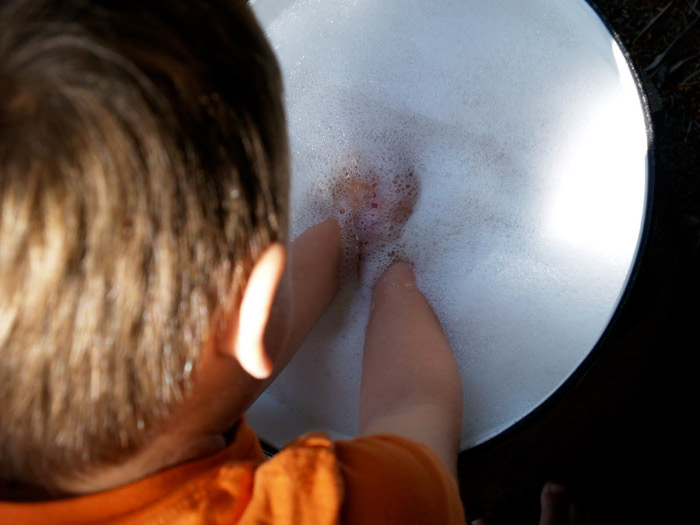
laundry
children
clothesline
Laura Ingalls Wilder
Indian Territory
wagon train
(Image credit: Donni via themagiconions.com)
Apr 23, 2018

Cine Fenix in Havana was once a 600-seat movie palace; since the revolution, it has been divided into apartments for ten families.
laundry
streetscape
Havana
Cuba
clothesline
ruins
theater
repurposing
(Image credit: Carolina Sandretto via Cines de Cuba)









 Women washing clothes circa 1900 in Alatri, Italy, 100 kilometers southeast of Rome.
Women washing clothes circa 1900 in Alatri, Italy, 100 kilometers southeast of Rome.






